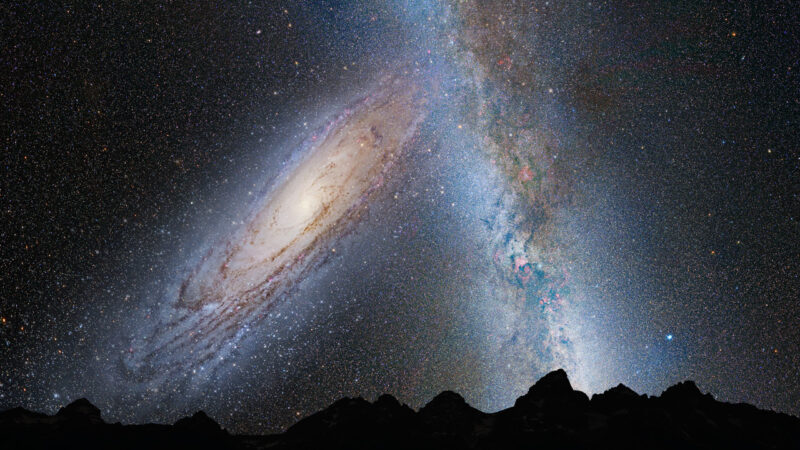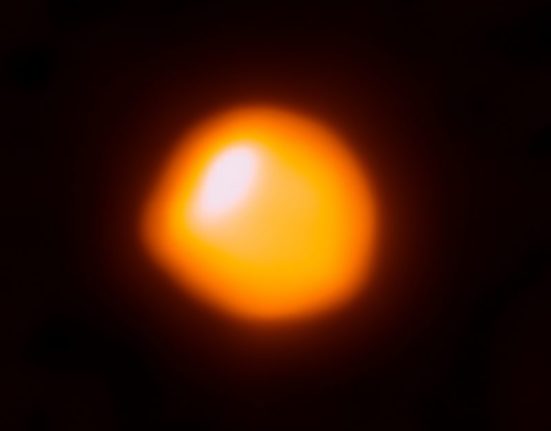
- Black holes just 300 light years away – closer than any other pair of supermassive black holes ever observed – have been found at the centers of two merging galaxies.
- The two black holes continue to approach each other and closer together, scientists say.
- This unusual duo of black holes is said to be mergingcreating a single new giant black hole.
NASA published this article on September 9, 2024. EarthSky Editions.
The black hole duo will eventually merge
For all practical purposes, stars traveling through space never collide with each other. The ratio of the diameter of a Sun-like star to its distance from the nearest neighboring star is about 1:10 million. However, galaxies do collide. By comparison, the separation between our Sun-like stars is 1:10 million. Milky Way Galaxy and neighbors Andromeda Galaxy It's amazing 2.2 million light yearsThat's a ratio of just 1:20. And eventually, there will be a collision and fusion Between the two giants.
When two galaxies collide, their central supermassive black holes They merge into a single giant black hole. In fact, almost all galaxies contain supermassive black holes at their centers. Now, the Hubble Space Telescope and the Chandra X-ray Observatory have peered into the heart of a colliding pair of galaxies and discovered twin supermassive black holes dancing around each other. The black hole duo, packed with infalling gas, shines brightly like active galactic nucleiThey are separated by about 300 light-years, the closest pair ever seen in visible light and X-ray wavelengths.
And they are getting closer and closer.

Cores of two galaxies on a collision course
As if they were two sumo wrestlers facing off, the closest pair of confirmed supermassive black holes has been observed. They are located about 300 light years away and were detected using NASA's telescope. Hubble Space Telescope and the Chandra X-ray ObservatoryThese black holes, buried deep within a pair of colliding galaxies, are powered by Falling gas and dustcausing them to shine brightly as active galactic nuclei (AGN).
This AGN pair is the closest detected in the local universe using multiwavelength (visible light and X-rays). While astronomers have discovered several dozen “dual” black holes before, their separations are typically much greater than those discovered in the gas-rich galaxy MCG-03-34-64. Astronomers using radio telescopes have observed a pair of binary black holes in even closer proximity than in MCG-03-34-64, but with no confirmation in other wavelengths.
Binary AGN systems like this were likely more common in the early universe, when galaxy mergers were more frequent. This discovery offers a unique, up-close look at a nearby example, located about 800 million light-years away.
How Hubble detected the black hole duo
The discovery was fortuitous. High-resolution Hubble images revealed three diffraction peaks nested within the host galaxy, indicating a large concentration of glowing oxygen gas within a very small area.
Ana Trindade Falcon of the Harvard & Smithsonian Center for Astrophysics in Cambridge, Massachusetts, lead author of the peer reviewed paper published September 9, 2024, in The astrophysical journal, saying:
We weren't expecting to see something like this. This sight is not common in the nearby universe and it indicated to us that something else is going on within the galaxy.
Diffraction spikes are imaging artifacts that occur when light from a very small region in space is bent around the mirror inside telescopes.
An X-ray view of a cosmic collision
Falcão's team then examined the same galaxy in X-ray light using the Chandra observatory to find out what is going on. Falcão said:
When we observed MCG-03-34-64 in the X-ray band, we saw two separate, powerful sources of high-energy emission that matched the bright optical points of light observed with Hubble. We put these pieces together and concluded that we were likely looking at two very close supermassive black holes.
To support their interpretation, the researchers used archival radio data from the Karl G. Jansky Very Large Array near Socorro, New Mexico. The energetic black hole duo also emits powerful radio waves. Falcão said:
When you look at bright light in optical, X-ray and radio wavelengths, you can rule out a lot of things and conclude that they can only be explained as nearby black holes. When you put all the pieces together, you get the picture of the AGN duo.
Unexplained light?
The third bright light source Hubble saw is of unknown origin and more data is needed to understand it. It could be gas receiving a jolt of energy from a ultra high speed plasma jet shot out from one of the black holes, like a jet of water from a garden hose falling onto a pile of sand.
The two supermassive black holes were at the core of their respective host galaxies. A merger between the galaxies brought the black holes closer together. They will continue to spiral closer together until they finally merge, perhaps within 100 million years, shaking the fabric of space and time. gravitational waves.
In short: The Hubble Space Telescope and the Chandra X-ray Observatory have detected a pair of black holes at the cores of two merging galaxies. These black holes will spiral together and eventually collide.
(tags to translate)space













Leave feedback about this